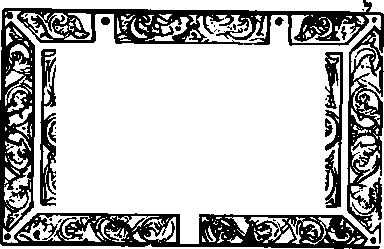Ivory Carvings. Part 3
Description
This section is from the "Historic Ornament - Treatise On Decorative Art And Architectural Ornament" book, by James Ward. Also see Amazon: Historic Ornament - Treatise On Decorative Art And Architectural Ornament.
Ivory Carvings. Part 3
Another Flemish artist in ivory was Francis von Bossuit, who spent a great part of his life in Rome, and whose figure carvings are of great value. Alessandro Algardi was an Italian artist of the seventeenth century, who carved the ivory bas-relief of St. Leo going out to meet Attila, now in St. Peter's at Rome, and also a very fine bust of Costmo II. de' Medici. One of the best ivory carvers that ever lived was Fran*Ħois Duquesnoy, known better as Fran*Ħis Flamand (1594-1644); he was a native of Brussels, and went to Rome when a young man for the purpose of study. He supported himself in his wanderjahr period by carving little figures in ivory and wood. In the Cluny Museum and in the Louvre some groups, and bas-reliefs of females and children, may be seen, executed by Flamand, that are full of roundness and life, boldly conceived and extremely graceful.
We have noticed how plentiful the ivory carvings were of the fourteenth century period; but at the end of that century ivory sculpture fell in abeyance, which lasted during almost the whole of the fifteenth and sixteenth centuries. This was due to the very great impulse given to wood carving by the French, and even more so by the German wood sculptors. Large wooden altar-pieces, or "retables," came into fashion, and also minute wooden portraits and statuettes, which for a long period superseded ivory carvings; and in Germany a good deal of carving was executed in "Speckstein" or Soapstone, a kind of drab-coloured lithographic stone that was not difficult to work. Albert DÂrer and Lucas Cranach carved some very fine works in Speckstein. At the beginning of the seventeenth century ivory carving became again in great request.
The Germans carried the arts of ivory and miniature wood carving, as they did the larger style of wood carving, to great perfection; in fact to an astonishing degree of dexterity, that would compare with Chinese or Japanese carving, but lacking in the restrained artistic power of the latter nation's productions. All kinds of astonishing creations are preserved in the museums of subjects such as little ivory carvings of skeletons in company with groups of female figures, miniature hunchbacks, and beggars with diamonds for buttons on their dresses. Leo Pronner, of Nuremberg, carved on a cherry-stone a hundred heads, that required the aid of a magnifying glass to see the expressions, and later Simon Troger, of the same city, produced many marvels in ivory figures with brown wood dresses and other accessories in wood.

Fig. 120. Lid of Ivory Cabinet; Spanish; Eleventh Century. (S. K. M).
Fig. 121. Coffer in Bone Carving and Engraved Work; Italian; Fourteenth Century. (S. K. M).
Fig. 122. Ivory Comb; Eleventh Century.
Fig. 123. Ivory Minor Case. (S. K. M).
Fig. 124. Ivory Tankard, Silver-gilt Mounted; Flemish; Seventeenth Century. (S. K.M).
Many good ivories have been the work of Spanish carvers, and as a rule they are tinted or coloured.
Nearly all the carvings in ivory that we have noticed have been statuettes, reliefs, or objects in which the human figure predominates.
As a matter of fact there are very few ivories of any artistic value in which the human figure is not the most important part of the composition, purely ornamental work being very rare. Even in Saracenic work, where the figure and animal representations are not found, the amount of carved ivory work is limited, and the specimens are very scarce.
In an ancient Coptic church in Cairo there is a massive . partition or screen of ebony, in which is a central door and two side panels. This screen has a rich display of inlaid ivory carved with arabesques, and has ivory crosses in high relief. The screen is believed by Mr. Butler - the author of "The Ancient Coptic Churches of Egypt" - to be a work of the tenth century, and also to be the model on which the ivory carving of the mosques was founded.
The Ivory Carvings In Saracenic Work
The Ivory Carvings In Saracenic Work are usually found as carved or chased panels, with arabesque designs, and surrounded with geometric linear framing (Fig. 125).
The best of this type of work was executed in the fourteenth century. Objects made of ivory alone are very rare in Saracenic art. The illustration given of an ivory ink-horn is unique in this material, but ink-horns of the same shape are common that have been made in copper and brass.
Figure And Animal Carvings Of Saracenic Or Moorish Design
Figure And Animal Carvings Of Saracenic Or Moorish Design have been made in Spain, and in some other countries under the rule of the Saracens, but are not found in the Egyptian Saracenic.
China has always been prolific in the production of ivory carvings. There are numerous statuettes of Confucius, Cheo?-lao, the god of old age, of the Buddhist female divinity Kouan-in, and of other divinities. Necklaces, pierced plaques for waist-belt decoration, and the su-chus or rosaries, all are carved with a certain archaic quality and quaintness, but of a minute and unsurpassed dexterity of workmanship.
Continue to:


